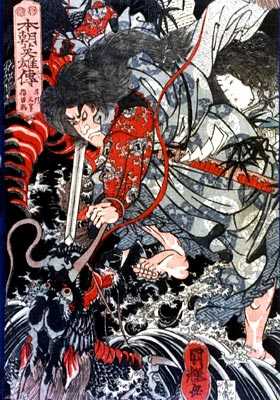Seven Lucky Gods
The Seven Gods of Fortune (七福神 Shichi Fukujin), commonly referred to in English as the Seven Lucky Gods, are the seven gods of good fortune in Japanese mythology and folklore. They are often the subject of netsuke carvings and other representations.
Names and patronage

Each has a traditional attribute:
- Hotei, the fat and happy god of abundance and good health
- Jurōjin, god of long life
- Fukurokuju, god of happiness, wealth and longevity
- Bishamonten, god of warriors
- Benzaiten (Benten-sama), goddess of knowledge, art and beauty, especially music
- Daikokuten (Daikoku), god of wealth, commerce and trade. Ebisu and Daikoku are often paired and represented as carvings or masks on the walls of small retail shops
- Ebisu, god of fishers or merchants, often depicted carrying a sea bream
History
Many figures in the Seven Lucky Gods were transmitted from India and China, including all of the Seven Lucky Gods except Ebisu. Daikoku-ten, derived from the Hindu god Shiva became intertwined with the local Shinto deity Ōkuninushi.[1] Another god, Kichijōten, goddess of happiness, is sometimes found depicted along with the seven traditional gods, replacing Jurōjin, the reasoning being that Jurōjin and Fukurokuju were originally manifestations of the same Taoist deity, the Southern Star. However, as is often the case in folklore, Japanese gods sometimes represent different things in different places.
The seven gods are often depicted on their ship, the Takarabune (宝船), or "Treasure Ship." The tradition holds that the seven gods will arrive in town on the New Year and distribute fantastic gifts to worthy people. Children often receive red envelopes emblazoned with the Takarabune which contain gifts of money around the New Year. The Takarabune and its passengers are often depicted in art in varied locations, from the walls of museums to cuddly caricatures.
Culture references
- Happy Seven is an anime about a school club consisting of seven girls, each one having a different power from the Seven Gods of Fortune.
- A character in Dan Brown's Digital Fortress prays to the "seven deities of good luck" at one point, but uses the term shichigosan, which actually refers to the festivals for children of the special ages of seven, five, and three.
- Pink film directors Toshiya Ueno, Shinji Imaoka, Yoshitaka Kamata, Toshiro Enomoto, Yūji Tajiri, Mitsuru Meike and Rei Sakamoto are known collectively as the "Seven Lucky Gods of Pink" (ピンク七福神 pinku shichifukujin).[2]
- The first Ranma ½ film, Ranma ½: Big Trouble in Nekonron, China, featured the seven lucky gods of martial arts as the primary antagonists.
- In a chapter from Ghost Sweeper Mikami, five of the Seven Lucky Gods left their boat. Mikami tries to convince them return to the boat.
- In The Eccentric Family, the members of the Friday Fellows share the names of the seven gods.
- In the anime Noragami the seven Gods of fortune appear frequently.
- In the anime series Shirobako the five lead characters make an amateur animated short based upon the Seven Lucky Gods, and plan to make a full-length feature version of it one day.
Location of shrines
- Toka Ebisu Shrine, Fukuoka
- Nanyo – Kanjizaiji (観自在寺), Shikoku
- Nishinomiya Shrine, Hyogo
- Imamiya Ebisu Shrine, Osaka
Gallery
-
The Seven Lucky Gods at Watatsumi Shrine in Tarumi-ku, Kobe
-

The Seven Lucky Gods in a woodblock print by Utagawa Kuniyoshi
-

The Seven Lucky Gods, in an 1882 woodblock print by Tsukioka Yoshitoshi
See also
- Three Star Gods, a similar group of auspicious deities from Chinese folk religion
Notes
- ↑ Roberts, Jeremy (2009). Japanese Mythology A to Z. Infobase Publishing. p. 28.
- ↑ Domenig, Roland (2002). "Vital flesh: the mysterious world of Pink Eiga". Archived from the original on 2004-11-18. Retrieved 2007-07-12.
External references
| Wikimedia Commons has media related to Seven Lucky Gods. |
| |||||||||||||||||||||||||||||||||||||||||||||


